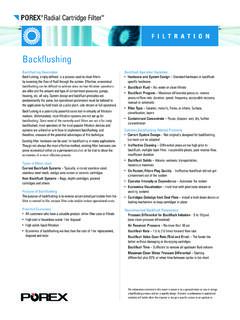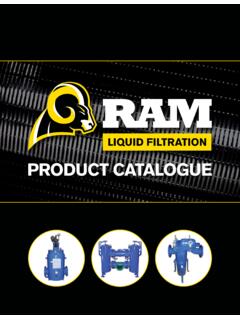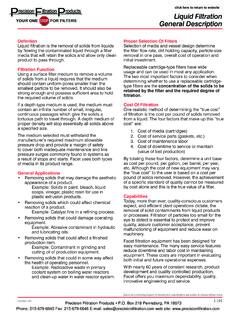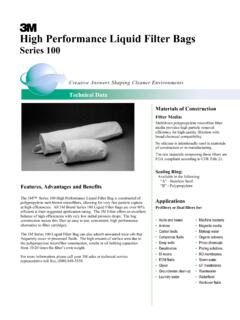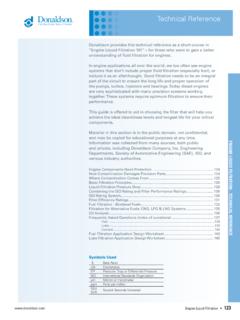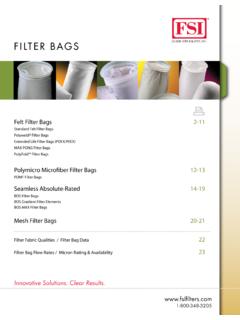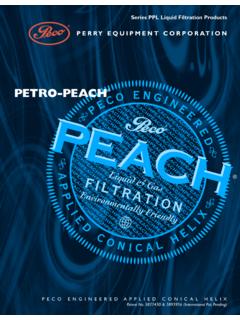Transcription of Gradient Structure Media for liquid Filtration Applications
1 Gradient Structure Media FOR liquid Filtration APPLICATIONSS tephanie R. Earley and Nicole AmslerKimberly-Clark CorporationRoswell, Georgia, Media with an engineered Gradient Structure can optimize the Filtration efficiency, pressure drop , and holding capacity of Media performance. An important part ofestablishing these properties for a specific application is to determine the porosity of themedia design. Through Media characterization, liquid Filtration Media can be designed tofit most Applications . Kimberly-Clark Corporation has designed a unique Media toprovide improved Filtration efficiency without sacrificing dirt-holding capacity. The mediais 100% polyolefin and is thermally bonded for strength.
2 This Media is chemicallycompatible with most liquid Applications and does not contain binders that can interferewith the fluid paper describes the parameters for developing a Gradient Structure and designing itfor specific Applications . The liquid filter Media used in these Applications clean better,clean longer and reduce end user a filter Media for a Filtration process requires information regarding the specificapplication. What is being filtered? What is the particle size of the particulates? Howmany of the particulates need to be filtered or what efficiency needs to be achieved?When choosing a filter Media , does the performance of the product outweigh the cost?When selecting a Media , what does the rating of the Media indicate?
3 These are just a fewof the questions a filter Media purchaser should ask when they are searching for the rightmedia to fit their most Applications , the ideal filter Media will provide a high Filtration efficiency, lowpressure drop and high dirt holding capacity. To accomplish all three of these attributes,the filter Media must capture the desired particles, minimize the pressure loss, and requireless frequent filter changes. Most Filtration Applications require a balance or optimizationof these three attributes. Kimberly-Clark has a unique process that can manufacturemedia with a density Gradient Structure and the proper pore Structure to enhance thisbalanced performance. The filter Media thickness and pore Structure are engineered usingfiber diameter, fiber crimp, and fiber arrangement.
4 An optimized pore Structure traps abroad range of particle sizes; thus the Media exhibits higher efficiencies and/or dirt holdingcapacity with minimal increase in pressure drop . Figures 1, 2, and 3 demonstratethickness and pore Structure differences within the same basis weight Figure 1: Low Loft (LL) Figure 2: Medium Loft (ML) 2 Figure 3: High Loft(HL)Cross section photographs of POWERLOFT Media osy at various thickness, 20xBefore presenting industry examples on the importance of Media characterization andfilter Media design, this paper discusses the different types of filter mechanisms, themeaning of pore characterization and how these material properties affect the Media DESIGNK nowing a customer s requirements prior to designing a filter Media is imperative.
5 Asnoted below, there are a variety of mechanisms and characteristics that play a role in filterperformance. These unique properties must be considered when manufacturing a filtermedia to achieve end user satisfaction. These characteristics and mechanisms ofteninclude filter loading, particulate size, filter life and filter efficiency. The cost toperformance ratio is another important consideration. The initial Media cost may be moreper square yard, however because the Media efficiency is greater, less Media is usedannually. During the oral presentation of the filter press case studies, the resultsdemonstrate increased coolant life leading to lower disposal costs, less frequent rollchanges and improved efficiency in metal working Applications .
6 Below, the differentcharacteristics and mechanisms in Filtration are four types of mechanisms in Filtration are briefly reviewed below. The twomechanisms that work as Gradient structures are depth straining and depth loading is a mechanism where the pores are smaller than the particlescollected on the surface of the filter (see Figure 4). As the surface loads, thedifferential pressure Filtration is a mechanism where a thick layer or cake of particlesaccumulates on top of the Media . These particles are usually larger than the poresin the Media (see Figure 5). This mechanism is effective in solids recovery becauseas the cake gets thicker, the efficiency can 4: Filtration by Surface straining4 Figure 5: Cake Filtration mechanism4 Depth Straining is a mechanism where the particles move through the Media andare physically entrapped in the web Structure (see Figure 6).
7 The pore sizes aresmaller than the particles retained. Particles smaller than the pore Structure willpenetrate through the Media . This application is widely used in liquid applicationsand in less critical air Filtration is a mechanism where particles smaller than the pore structureare trapped within the Media . This mechanism involves several complex forces,such as impaction, interception and diffusion, which act on the particles and resultin high efficiency (see Figure 7). These forces all depend on the relationshipbetween Media construction and particle size to provide high efficiency in 6: Filtration by depth straining5 Figure 7: Depth Filtration mechanism5 Depth straining and depth Filtration are both mechanisms that work in Gradient structuremedia.
8 The pore Structure is open on the face of the filter and the packing density offibers and their diameters can change through the filter and result in more restrictive tortuous path results in improved efficiency and life with minimal pressure of these Filtration mechanisms allow greater utilization of the filter Media in the Structure DesignInnovations at Kimberly-Clark have provided advancement in Filtration Media . Filtermedia, in general, provide some level of efficiency, pressure drop and holding improve the performance in one area, the functionality of the filter is usuallycompromised in another area. Kimberly-Clark Filtration Products uses a proprietaryprocess that can control the fiber forming process to balance these three attributes foroptimum filter Media performance.
9 The process can customize fiber diameter and fiberarrangement to create Gradient structures. These structures are beneficial in both liquid andair Filtration fibers in POWERLOFT Media are 100% polyolefin, specifically polypropyleneand polyethylene. The dual polymer construction of the fiber allows the manufacturingprocess to be adjusted to control fiber diameter, fiber density, fiber crimp and bondstrength between fibers. With control over these fiber properties, the construction of filtermedia can be designed with a pore Structure to meet desired Filtration on the size of the particles to be removed, the pore Structure is built to filterthese particles with the optimum balance between Filtration efficiency, holding capacity,and pressure drop .
10 The following sections discuss how pore characterization is used tocharacterize and design Media to fit the needs stated AND CHARACTERIZATION OF A POROUS MEDIUMA ccurate pore size determination is critical in determining how effective a material willperform in its final application. Knowing the rating of a filter Media and understandingwhat this rating means is necessary for selecting the correct Media for an application. Ifthe product is labeled as a five-micron nominal product, does this mean it will filter out100% of the particles five-microns and larger? Or is it stating that it will remove most ofthe particles close to five-microns? How did the filter manufacturer arrive at this rating?
